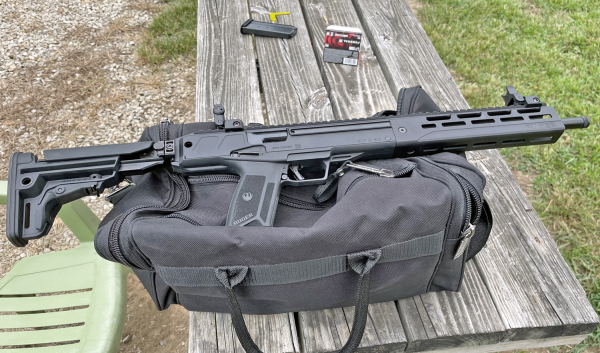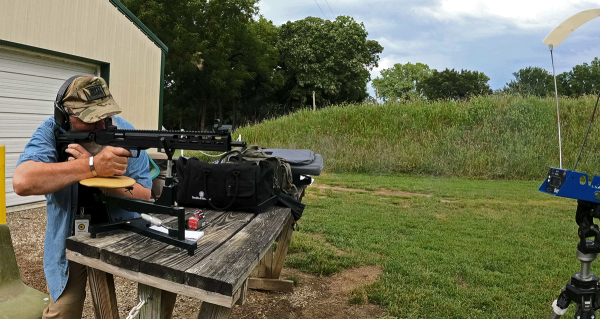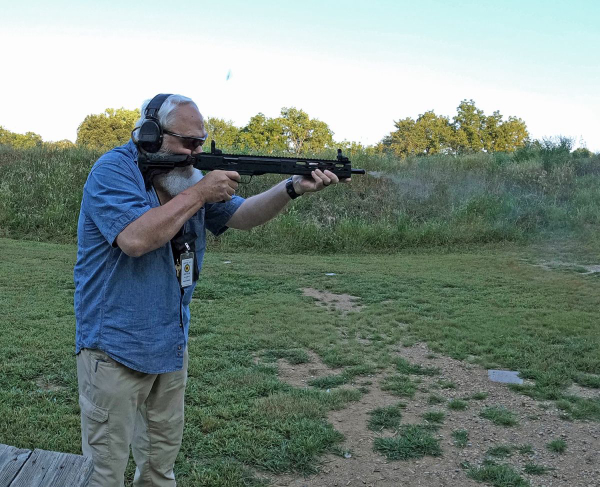What follows is team coverage of the new LC Carbine from Ruger. The first part is an initial examination of the new gun, with "Part II" being the use and application of the LCC.
Yesterday, Ruger announced the LC Carbine (“Lightweight?”). Chambered for a cartridge that’s been here and, except for NATO adoption, nearly gone, and back again – the 5.7x28mm.
“Aw, that’s just a 22 Magnum.”
Yeah, that’s what I thought too – and reported as much back in the print gun magazine days, when I covered the FN FiveSeven pistol and the carbine too.
But it’s been and gone and back. Ruger made a pistol here awhile back and now they’ve taken that pistol design and fiddling with it – including some innovations – until they got the LCC.

So what is it? The release refers to the ‘bolt-over-barrel design’ – something you see when you lock the bolt back. The magazine – in the Ruger 5.7 pistol format – fits into the grip frame. The stock – adjustable for length of pull and compatible with AR-pattern/Pic-rail mounted aftermarket accessory stocks – swings out of the way to the left.
Unless you want to configure it to go the other way. Likewise, the forward mounted charging handle, which appears on the left as the piece falls out of the box, can be moved to the right side.
The barrel length is 16 ¼”, so as not to offend bureaucrats. The anodized aluminum CNC-milled handguard features M-LOK accessory attachment slots. The sights, known as Ruger “Rapid Deploy” adjustable sights (appearing to be related to the MBUS), likewise can be folded down for storage.
If you have a Ruger-5.7 pistol, you’ll be very familiar with the LCC. The magazines and controls mirror the pistol’s. The hammer-fired action is likewise similar to the R5.7 and has similarities to the LCPII, Security-Nine and MAX-9 pistol lines.
The barrel, fluted and nitride-coated, is threaded for muzzle devices – our Esteemed Publisher has made use of the threaded muzzle as he’ll share below.
The gun weighs in at less than six pounds. The magazine, shared with the Ruger pistol of the same caliber, holds 20 rounds. The gun is expected to retail for around $980.
The gun is packaged with a magazine, an ambidextrous magazine release button, M-LOK QD sling socket, front sight adjustment tool, and hex wrenches to assist in disassembly.

I made an early trip to the range to avoid on-lookers (the project was still under wraps) and sought to get some accuracy work done. From a hasty rest at fifty yards using the Rapid Deploy sights, five 40 grain Federal American Eagle FMJ bullets clustered into 5 ½” with the best three hits occupying about 3 ½”. For me, that’s not terrible. A better rest, some glass (I am old) and with more light (it was early), and I expect it would be quite a bit better.
Using the aforementioned 5.7x28mm Federal American Eagle 40gr. FMJ, the chronographed velocity at ten feet averaged 2,392 FPS in 16” – that is not a 40 grain 22 Magnum (40gr. Maxi-Mag tends to generate around 1,800 fps in 16”). The rounds hit four inches low – that was close, I believe it was either zeroed at the factory or good luck. I’ll likely zero at fifty yards then check to see how close I am at 100 yards.
While I don’t have a selection of 5.7x28mm ammo (does anyone?), I have a supply of Federal American Eagle (thanks to Federal Premium), so I’ll zero the piece with that.
It's not a 22 Magnum. It has the blast of a 22 Magnum, the recoil of a 22 LR fired out of a rifle – and superior velocity to both of them for a pill of the same size. The controls are fairly intuitive – as soon as you recall it’s a magazine ejection lever, not a button. Also, don’t foul the charging handle when loading.
On another early morning trip, I worked closer to the target to try some gunhandling exercises with the little carbine. I worked from 10 to 20 yards – further than home defense distances for most of us). The little gun cries out for a low-powered variable optic for farm and ranch use where distance can be a thing – but so can close ranges.

I found 2 ½” offset between the top of the front sight and the center of the bore. I was hitting about 3” low – consistent with my fifty-yard results from the first trip. I found the safety a bit hard for me to reach – I’m used to 1911s – and the trigger was a bit stagey. The gun doesn’t really kick, but the movement of the two-piece bolt on this blow-back design does jar the sights as the gun returns to battery.
It doesn’t move the gun far, but “outrunning the headlights” could be a thing for me. A solid hold and good technique go a long way toward keeping that muzzle still.
Compact for camper, woods-walker, farmer, rancher or – when aware of local laws – traveler, this can fit the bill for the disabled and elderly as well.
-- Rich Grassi